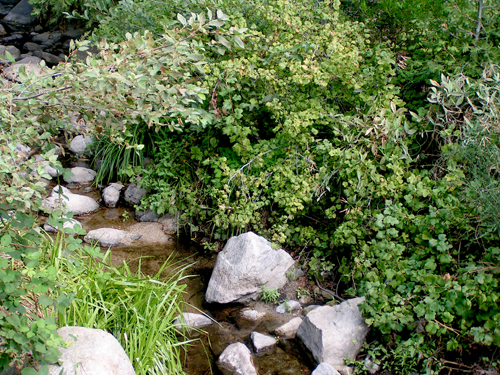A creek runs through it: Strawberry Creek and right of public access

Strawberry Creek, running through the center of Idyllwild, is a reminder of why many choose to live here — fresh mountain stream water coursing through a tranquil and unspoiled creek-carved canyon, the sound of its water burbling over rocks and falling into pools, the wildlife habitat it provides, and the fish, that for generations have swum in its pools and enticed fishermen and women.
The public pleasures of Strawberry Creek are many and have been enjoyed by Hill residents since before the arrival of white settlers. The tradition of fishing in Strawberry Creek goes back hundreds of years. And the fact that the California Department of Fish and Game stocks the creek, and has done so since the 1980s, is evidence of its recognition of the right of the public to use and enjoy the creek and its defined borders on each side.
But Department of Fish and Game Senior Environmentalist Mike Giusti explained that under California law and DFG policy, the right of public access is preserved to the “ordinary high water mark” of the creek for purposes of fishing as well as environmental and related public recreational activities. That does not mean, according to Giusti, that the public can cross private property without permission to get to the creek.
Although not clear as of this writing, there is the possibility that Idyllwild Pines Camp management may restrict creek access as part of a limitation on public access to the campus and management concerns over security. Executive Director Martha Snyder did not respond to inquiries about the camp’s position on public access to Strawberry Creek, which runs through the camp.
As long as there are public access points, for instance, at a county or state bridge crossing, or from other private contiguous property where public access is allowed, public access to the creek may not be curtailed, according to Giusti.
Idyllwild All Year Resort owns creek access property both above and below Idyllwild Pines Camp according to President Jay Johnson, and has always permitted public access on creek property it owns. “I grew up fishing in that creek,” Johnson said. “My dad fished in it. We have always allowed public access.”
“The water in the creek is a public resource,” Giusti said. “And the public has a right to that public resource. If there is a way to access creek waters from publicly owned land, and those access points are suitable for stocking [fish], then the public is entitled to pursue that access to the ordinary high water mark. Fish stocking is dependent on water flow but that factor does not affect or impede public access.”
Notwithstanding what Giusti and others view as settled law, should a dispute develop over right of public access in the unincorporated areas of Riverside County, the Board of Supervisors has jurisdiction to mediate the dispute.
Under Government Code Section 25660 through 25662, “On the application of any person interested, the board of supervisors may by ordinance declare all or any portion of any slough, river or stream to be a public highway for the purpose of fishing therein.”
For board of supervisor jurisdiction to apply, the stream cannot lie within or run through county cultivated (farm) land, the stream is stocked or supplied in whole or in part with fish by the state or counties (in the case of Strawberry Creek by the state Department of Fish and Game), and the stream “has not been declared by law to be navigable and in fact is not navigable for commercial purposes.”
The law further stipulates that the BOS may open negotiations with an unconsenting landowner to mediate a solution that preserves public use.




